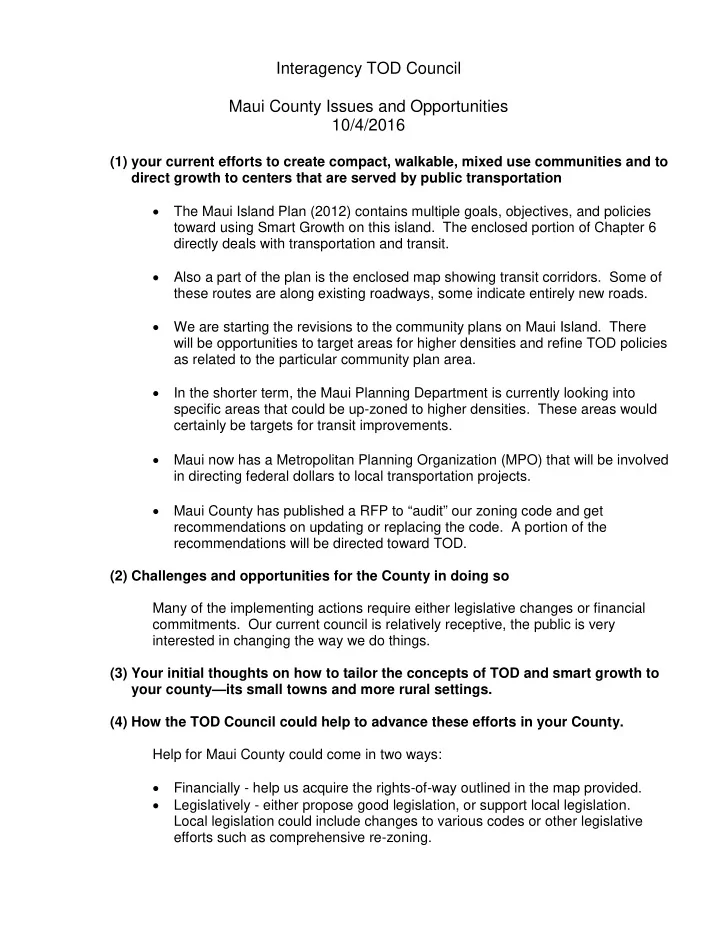

Interagency TOD Council Maui County Issues and Opportunities 10/4/2016 (1) your current efforts to create compact, walkable, mixed use communities and to direct growth to centers that are served by public transportation • The Maui Island Plan (2012) contains multiple goals, objectives, and policies toward using Smart Growth on this island. The enclosed portion of Chapter 6 directly deals with transportation and transit. • Also a part of the plan is the enclosed map showing transit corridors. Some of these routes are along existing roadways, some indicate entirely new roads. • We are starting the revisions to the community plans on Maui Island. There will be opportunities to target areas for higher densities and refine TOD policies as related to the particular community plan area. • In the shorter term, the Maui Planning Department is currently looking into specific areas that could be up-zoned to higher densities. These areas would certainly be targets for transit improvements. • Maui now has a Metropolitan Planning Organization (MPO) that will be involved in directing federal dollars to local transportation projects. • Maui County has published a RFP to “audit” our zoning code and get recommendations on updating or replacing the code. A portion of the recommendations will be directed toward TOD. (2) Challenges and opportunities for the County in doing so Many of the implementing actions require either legislative changes or financial commitments. Our current council is relatively receptive, the public is very interested in changing the way we do things. (3) Your initial thoughts on how to tailor the concepts of TOD and smart growth to your county—its small towns and more rural settings. (4) How the TOD Council could help to advance these efforts in your County. Help for Maui County could come in two ways: • Financially - help us acquire the rights-of-way outlined in the map provided. • Legislatively - either propose good legislation, or support local legislation. Local legislation could include changes to various codes or other legislative efforts such as comprehensive re-zoning.
I NFRASTRUCTURE AND PUBLIC FACILITIES Hāna Highway is a major roadway infrastructure and gateway to central Maui. T RANSPORTATION Streets and highways are currently the primary infrastructure supporting Maui’s transportation system and play a major role in shaping settlement patterns. The quality of the roadway system affects various modes of travel including automobile, transit, bicycle, and pedestrian. The condition of Maui’s roadway system also impacts the safety of all roadway users, the movement of goods and products, efficiency of emergency public services, and quality of life. This system experiences increasing demand associated with island growth and development. A key outcome, therefore, is to maintain, improve, and expand where necessary the existing roadway system, and expand multimodal transportation to improve traffic flow, safety, and efficiency. Maui ui Co Coun unty Gene enera ral Plan 2030 030 6-26 Maui ui Island nd Plan
I NFRASTRUCTURE AND PUBLIC FACILITIES Maui’s road network is comprised of both State and County roadways that provide connections between the island’s major urban centers and circulation within communities. Major highway systems on the island include Honoapi`ilani and Kūihelani Highways, which connect Central and West Maui; Mokulele and Pi`ilani Highways, which connect Central and South Maui; Hāna Highway, which connects Central and East Maui; and Haleakalā and Kula Highways, which connect Central and Upcountry Maui. According to the State Department of Transportation (DOT), the average daily traffic volumes indicate that Maui’s most heavily-traveled roadways during the day are Honoapi`ilani Highway, Ka`ahumanu Avenue, and Hāna Highway. Existing Plans and Programs The DOT has jurisdiction over State roadways while the County of Maui, Department of Public Works, Highways Division, has jurisdiction over County roadways. The primary program governing improvements to Maui’s roadway network is the Hawai`i Statewide Transportation Improvement Program (STIP). The STIP provides a multi-year listing of State and County projects and identifies those projects slated for Federal funding. It is a multimodal transportation improvement program that is developed utilizing existing transportation plans. The STIP delineates funding categories including the Federal and local share of funding required for each project. Maui’s roadway network was assessed in the Proposed Roadway Development Program, Fehr & Peers and Kaku Associates, (2007). The purpose of this study was to provide a current and future (2030) capacity assessment of Maui’s roadway network pursuant to proposed land use and development trends. This study was used as the primary source of information for this Transportation Section. See Diagram 6- 2 for a depiction of existing and conceptual transportation options. Table 6 - 4: Proposed Highway Improvements Up-Country - Kīhei Corridor Wai`ale/Kūihelani Hwy Connector Honoapi`ilani Realignment-aka Lahaina By-Pass Lono Ave extension to Kūihelani Hwy Phase A Keawe St. to Lahainaluna Road Phase B Lahainaluna Road to Launiupoko `Imi Kālā /Pihana extension (bridge) Phase C Keawe St. to Honokowai `Imi Kālā /Wai`ale -Mill St, extension Paniolo Connector (Haleakalā Hwy - Baldwin Ave) Pali to Puamana Parkway-aka Honoapi`ilani Realignment Mā`alaea to Ukumehame Keawe St. Extension Kahekili Hwy widening Mill Street Extension (Aholo St. to Keawe) Maui Lani Parkway Pā`ia By-Pass Kuikahi Drive Extension Kīhei North-South Collector Road Kehalani Collector Road Kīhei Mauka By-Pass Kehalani Loop Road Wai`ale Extension Kahului Airport C HALLENGES AND O PPORTUNITIES Although the implementation of proposed roadway improvements will certainly help Maui’s roadway network, traffic congestion will remain an important quality- of-life issue. The expansion of the roadway network should not be considered the only solution for addressing transportation and mobility on the island. The following issues present some essential factors in planning for an effective transportation and mobility system on Maui. Maui ui Co Coun unty Gene enera ral Plan 2030 030 6-27 Maui ui Island nd Plan
Recommend
More recommend